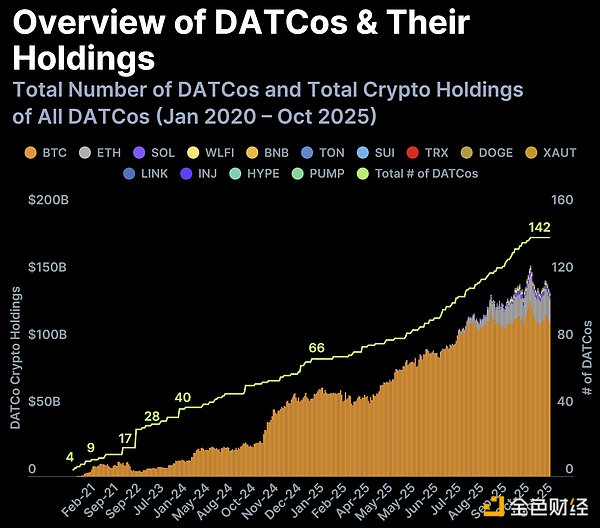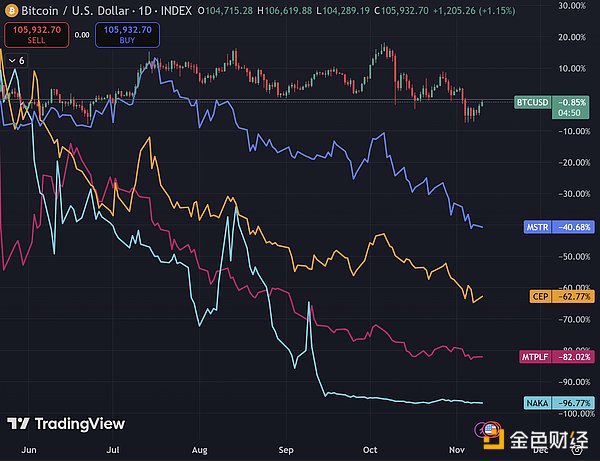Author: Jack Inabinet, Senior Analyst at Bankless
Translation: @Golden Finance xz
Digital Asset Treasuries (DAT) have become one of the explosive phenomena of this crypto cycle.
These publicly listed companies have made the accumulation of crypto assets a core strategy, investing billions of dollars into their selected digital assets—from Bitcoin and Ethereum to Hyperliquid tokens and even Tether Gold tokens! According to CoinGecko's "2025 Digital Asset Treasury Report," as of October, there are already 142 such companies.
Although DATs were in the spotlight earlier this year, with their numbers growing exponentially (new entrants using over a dozen cryptocurrencies to chase the skyrocketing stock price replication effect), most of these stocks have been marginalized, especially under the overall weakness of the crypto market.
This article will delve into the reasons behind the continued poor performance of DATs and the risks that these publicly listed companies may pose if the market turns.
1. Is DAT Growth Slowing?
It is no secret that the crypto market has performed poorly in 2025.
Despite the industry being flooded with seemingly positive headlines at the beginning of the year, as I pointed out last week, the total market capitalization of cryptocurrencies (TOTAL) has still underperformed compared to stock market benchmarks (S&P 500).
Mainstream coins Bitcoin and Ethereum are trading at roughly the same price as at the beginning of the year, while many leading altcoins have suffered indiscriminate crashes—once-popular coins (including ATOM, ENA, PENGU, and WIF) have all seen declines of over 50% this year.
However, while crypto tokens have faced continuous sell-offs throughout the year, DAT charts have shown a one-sided upward trend, both in terms of the number of companies and the value of their crypto asset holdings.

For a considerable period in mid-2025, it seemed a natural choice for underperforming publicly listed companies to pivot to the DAT model: stock prices often surged after announcing the transformation, creating multiple returns for company insiders overnight. Correspondingly, the selected cryptocurrencies gained a new source of price-insensitive demand from DATs—these DATs would accumulate as many tokens as possible.
Although this positive-sum relationship incentivized a large number of companies to adopt DAT strategies in 2025, the fervor is cooling. The stock prices of new DAT projects are now predictably plummeting within days of their launch, with some even falling below pre-transformation prices…
For example, Nakamoto (a Bitcoin treasury company, stock code NAKA), led by Bitcoin Magazine CEO David Bailey, has continuously set historical lows just six months after becoming a DAT. The stock is now down 81% from its pre-transformation price and about 99% from its historical peak (set ten days after the DAT announcement).
A more recent case is Forward Industries (a Solana treasury company, established in early September, directly supported by the largest institutional investors in that blockchain, including Multicoin Capital, Galaxy Digital, and Jump Crypto). Its stock price has fallen 75% from its historical peak (set seven days after the DAT announcement) and is now 33% below its pre-transformation price.
The disillusionment of the DAT dream is evident in various asset data, as the scarcity premium once exclusive to blue-chip stocks (MSTR) seems to be dissipating along with the later homogenized DATs.

2. DAT Risks
DAT stocks can be likened to call options on the cryptocurrencies they hold: the token price must be above a specific threshold on a certain future date; otherwise, the stock will lose value—because the reserve assets must be liquidated to repay debts.
New DAT projects have not yet been affected by the general liquidity slump in the crypto market. However, the continued stagnation of cryptocurrency prices has begun to trouble the valuations of this inherently time-sensitive industry.
DAT amplifies potential returns for shareholders through borrowing. This strategy is reasonable when tokens perform better than the dollar, but if the opposite occurs, leverage will quickly threaten shareholder returns.
Technically, DATs cannot be "liquidated," as their leverage is generated through the issuance of periodic debt (which does not need to be repaid before maturity). But this does not mean that DATs will not sell their crypto reserves.
ETHZilla, backed by Peter Thiel, sold $40 million worth of Ethereum reserves last month to buy back shares from investors. Similarly, Swan-backed Sequans sold 970 BTC last week to repay debts early, becoming the first BTC-type DAT to liquidate reserves.

Moreover, although many current management teams of DATs express no intention to sell their crypto reserves, as publicly listed companies with shareholder rights, DATs may be forced to liquidate their treasury assets in the event of a hostile takeover.
The crypto-native space is no stranger to similar "risk-free value" treasury raids: acquiring a majority stake in distressed DeFi protocols with the intent to liquidate their treasury assets for value exceeding that of the protocol itself.
If these hundred or so DATs, which you have never heard of, trade at a deep discount to their net asset value (NAV) due to existing shareholders' disappointment with profits, other investors may seize the opportunity—this time expecting to profit quickly through treasury liquidation, which may further drag down the prices of the underlying tokens.
免责声明:本文章仅代表作者个人观点,不代表本平台的立场和观点。本文章仅供信息分享,不构成对任何人的任何投资建议。用户与作者之间的任何争议,与本平台无关。如网页中刊载的文章或图片涉及侵权,请提供相关的权利证明和身份证明发送邮件到support@aicoin.com,本平台相关工作人员将会进行核查。




